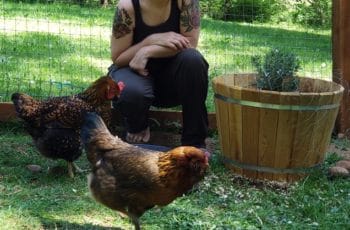Noses to the ground, seven Boykin Spaniels range across open grassland and into a forest of oak and hickory trees. They’re followed by a rangy guy in an orange high-viz vest and a pack of researchers in green vests. As one of the dogs nears a find—in this case, a three-toed box turtle—her tail begins wagging wildly. Once she locates the turtle, she carefully picks it up in her mouth, then returns to the group of humans trailing in her wake. There, she releases it into a waiting hand, gets a lot of praise, then goes back to work.
Boykin Spaniels, a compact flushing and retrieving breed that originated in South Carolina (and SC’s state dog), are known for their soft mouths—a behavioral tendency to pick up, hold and carry quarry gently. This skill, along with their excellent sense of smell, is being put to good use by the St. Louis Zoo’s Box Turtle Project, run by researchers with the zoo’s Institute for Conservation Medicine.
Research Fellow Maris Brenn-White, DVM, MPVM, explains why the dogs were enlisted in this project: “[We have] been studying box turtles in the St. Louis area for nine years now. In that time, we’ve learned how difficult it can be to find box turtles just by looking with the human eye. Box turtles have evolved to blend in perfectly with their surroundings, which is perfect for escaping predators but presents researchers with a real challenge. Based on some of our recent research findings, we started a new study on an emerging virus in three-toed box turtles that required us to locate a number of box turtles in a short period of time.”
Knowing the successes that other conservation groups have had using detection dogs, and the studies that have shown their safety and efficacy, the researchers asked their peers for suggestions. Here’s what they heard: When it comes to turtles, John Rucker is the man to see. Rucker, a retired teacher and self-taught naturalist, is a South Carolina native who now lives off the grid in Montana, where he raises and trains Boykin Spaniels. For almost two decades, his summers have been spent traveling the country with his “turtle dogs” to assist scientists with box-turtle conservation work.
GET THE BARK NEWSLETTER IN YOUR INBOX!
Sign up and get the answers to your questions.
Earlier in his life, Rucker lived in North Carolina and trained dogs to retrieve birds bagged by hunters. Then, some of his dogs spontaneously started to bring him turtles (unharmed and undamaged, as you’d expect from a soft-mouthed dog). He rewarded and shaped that behavior and grew his turtle-tracking pack with new dogs, who learned a large part of their job from watching and following the older dogs. Eventually, he decided to turn the accident into a business and let the dogs do what they naturally wanted to do.
Rucker starts turtle-dog training when the pups are three to four months old. Using scent and a form he created from the shell of a dead turtle, he teaches the dogs to recognize the turtle shape. By the time they join older and experienced turtle dogs in the field, he says, they’re able to make the leap from the form to the wild box turtle fairly easily.
This is the first time the Institute for Conservation Medicine has used dogs as helpers in any of their studies. However, Dr. Brenn-White notes, they are “studying dogs’ free-living relatives—coyotes and foxes—on the Saint Louis Zoo WildCare Park property.” She goes on to make a thought-provoking point: “Understanding how our pet and working dogs interact with and affect native species is a very important part of that study, and of much of our local and global conservation work. In conservation, we often encounter dogs as predators, competitors and sources of disease for threatened wildlife. This was a really great opportunity to see how dogs can work for conservation when we train and care for them in the right ways.”


